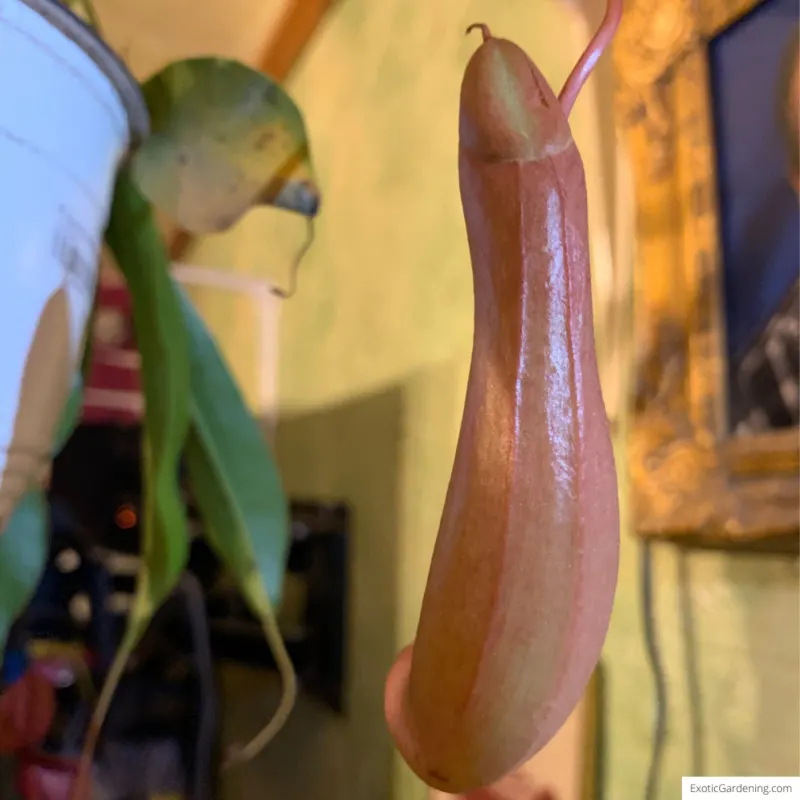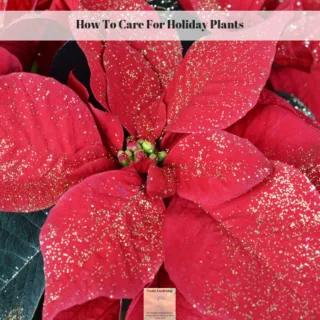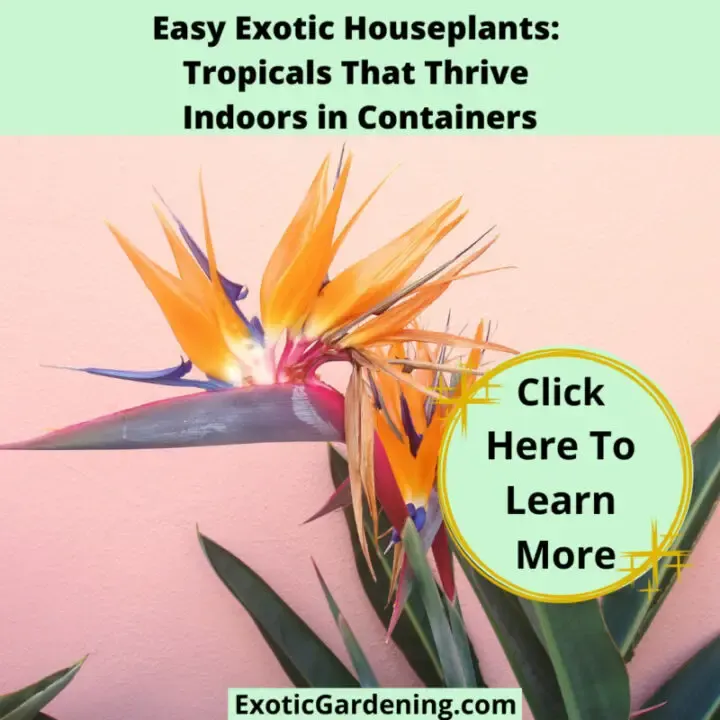My love of exotic pitcher plants is something I blame on HGTV and here is why.
I was watching Home & Garden Television one day when a beautiful red pitcher shaped plant was shown.
This made me curious.
I went on an all out search for this beauty, nicknamed the pitcher plant, botanically known as one of three families - Sarraceniaceae, Nepenthaceae And Cephalotaceae.
For any of you who have seen the episode this plant was on, I’m sure you’ll recall how beautiful his plant was.

Exotic Pitcher Plants Aren't The Easiest Houseplant
Needless to say, the first pitcher plant I bought had a different idea of what a pitcher was than what I had seen on HGTV.
Unfortunately for me, I killed a few pitcher plants before I figured out how to successfully grow them.
In nature, these beauties grow in wet boglands, so why not create a wet bogland inside an aquarium?
Needless to say, I’m on my way to growing some more of these exotic beauties.
But, just what is a pitcher plant and what do they do?
Exotic Pitcher Plants Devour Insects
The exotic pitcher plant, as it is commonly called belongs to three different families of flowering plants that use their leaves which are shaped like pitchers to trap insects.
When the pitchers first form, they are closed like the photo above, but as they mature, they open up so inspections can get inside.
The pitchers produce a sweet nectar on the top of the plant to attract insects.
The insides of the pitchers are lined with downward-pointing hairs that are used to prevent the insect from escaping once it is in the pitcher.
Juices that are contained in the bottom of the leaf eventually digest the insect.
Exotic Pitcher Plants Introduction
The three families of pitcher plants are the Sarraceniaceae, Nepenthaceae, and the Cephalotaceae.
Although there are many different types and sizes of pitcher plants out there, we will look at only a few.
The fascination of these native perennials seems to continue even after you’ve grown one or two.
Could it be there unique flowers, their foliage, or maybe just the ability to rid the world of an overabundance of insects?
Cephalotus
The Cephalotus grows pitchers that are only about 2 ½” long.
This pitcher plant is said to be one of the more difficult ones to grow, possibly because of the fact that its roots must have plenty of room to grow, or it is sure to die.
The only species of this plant is the follicularis.
Darlingtonia
The Darlingtonia, or Cobra Lily as it is commonly called, has only one species also, the californica.
This is supposed to also be difficult to grow.

Nepenthaceae
The Nepenthes grows the large pitchers that you may have seen on TV.
These pitchers grow when swelling of the mid-vein in the leaf starts, and they have two different ways of trapping insects.
One is by using the hairs we talked about above, but some of these larger pitchers don’t have the hairs and trap their prey by producing a slick, waxy surface on their interiors that insects can’t climb up.
So once they are inside the pitcher, they are trapped.
This is the one I like the best and as long as you keep the soil moist and high enough humidity around the plant, it does fine as a houseplant.
Exotic Pitcher Plant Propogation
An interesting fact about Nepenthes is that, even after the seeds have been dormant for awhile, there is still a possibility of germination.
According to Phill Mann, a specialist in Nepenthes, “My answer regarding germination of the Nepenthes seeds was that provided the seeds are treated correctly they will last up to 12 - 14 months. I had seed of N. fusca that I had collected in Sabah that I managed at least 90% germination after 14 months. Seeds of species such as N. bicalcarata and N. ampullaris seem to have a very short life of a matter of weeks. When considering the climate where they occur, it is possible that the seed never actually "dries" and there must be a considerable percentage of moisture all the time."
"Seed collected should be "dried" to avoid molds taking over and then I place them into the small envelopes and into a plastic bag. These then are stored in the "butter" section of the refrigerator. In vitro germination usually takes 11 days to 3 months. I have had the occasional seeds still germinate after 6 - 7 months. I think it mainly depends on how long you can keep the cultures going before they dry. My biggest problem is room so seeds rarely stay longer than 5 months in the vials. Sterilization would play a large part in germination, as factors such as too much bleach (or too long), insufficient rinse after sterilization would definitely have adverse reaction in germination."

Potential Pitcher Plant Propagation Problems
"Generally I find that glasshouse produced seeds are the worst for fungal attack. One theory put forward was that a glasshouse is so moist all of the time, that seed will take longer to mature and ripen, allowing contamination to invade the capsules," according to Mann.
Are you are wondering where you can get your own pitcher plant at?
Plant Delights Nursery, Inc. has quite a nice selection.
In fact, Plant Delights Nursery, Inc. has a nice selection of all kinds of unusual plants and I highly recommend them!
Discover the Joy of Houseplants: Your Ultimate Resource Guide
Welcome to the ultimate guide for all things houseplants! Whether you’re a seasoned green thumb or just starting your indoor gardening journey, this curated list of articles has something for everyone. From detailed care instructions to creative decorating ideas, troubleshooting common issues, and learning about unique plant varieties, you’ll find everything you need to keep your indoor jungle thriving.
Explore topics like:
Essential care tips for popular houseplants.
Solutions to common problems like pests, watering mistakes, and lighting challenges.
Creative ways to display and style your plants.
Propagation guides to grow your collection.
Get inspired, troubleshoot challenges, and cultivate the lush, vibrant indoor space you’ve always dreamed of. Dive in and let your houseplants flourish with these helpful resources!
Mastering South-Facing Window Plants: Expert Tips for Your Lush Oasis
Discover the secrets of success with South-Facing Window Plants in our comprehensive guide. Transform your space into a green haven.
Transform Your Cozy Corner with these Perfect Plants for Small Spaces
Discover the beauty of compact gardening with our guide on choosing and caring for plants for small spaces.
The Complete Guide to Philodendron Pink Princess Care
Introducing the Philodendron Pink Princess
Allow me to introduce you to the crown jewel of my botanical collection – the enchanting Philodendron Pink Princess.
This recent addition is nothing short of a horticultural masterpiece, captivating the senses with its breathtaking display of colors.
Imagine deep, luxurious burgundy leaves, each adorned with bold splashes of vivacious pink.
The contrast is nothing short of a visual symphony, a natural work of art that commands attention.
As I gazed upon it for the first time, I couldn't help but marvel at the sheer beauty and grace that this plant exudes.
If you've never had the pleasure of setting your eyes on a Philodendron Pink Princess, consider yourself in for a treat beyond compare.
It's more than a plant; it's a showstopper, a conversation piece, and a living testament to the wonders of the natural world.
This captivating botanical gem promises to be a source of endless fascination and admiration in any space it graces.
Spider Plants: The Perfect Gateway Plant for Gardening Enthusiasts
Spider plants, the perfect gateway plant, add charm, purify air, and are ideal for beginners and seasoned gardeners alike.
Spider Plant Light Requirements: A Key to Growth
Explore Spider Plant light requirements for thriving indoor growth. Learn key tips for optimal lighting conditions and vibrant greenery.
How to Grow Spider Plants
Discover how to grow spider plants with expert tips on light, watering, soil, and more for thriving plants!
5 Creative Spider Plant Display Ideas for Your Home
Discover creative spider plant display ideas to elevate your home decor with unique, stunning, and easy-to-implement solutions.
5 Fun DIY Projects with Spider Plants
Explore creative DIY projects with Spider Plants, including terrariums, macramé hangers, and upcycled planters for vibrant decor.
10 Fascinating Facts About Spider Plants You Didn’t Know
Discover fascinating facts about spider plants, including their care, propagation, and unique qualities that make them standout houseplants.
Top 10 Common Spider Plant Problems and How to Fix Them
Discover solutions to common spider plant problems like brown tips, yellow leaves, and droopy growth to keep them thriving.
How to Propagate Spider Plants: A Step-by-Step Guide
Learn how to propagate spider plants with easy, step-by-step instructions to grow vibrant, healthy indoor plants effortlessly.
Rustic Interior Decorating Idea With Tropical Plants
Metal cages or even old bird cages filled with plants are a great way to add a rustic touch to your interior decor.
Plumeria: The Lei Flower Is A Fragrant, Easy To Grow Houseplant
Learn how to care for your Plumeria in ground and in containers. Because of the winter dormancy period it is ideal for summer containers.
Indoor Flowering Tropical Plants
There are a number of indoor flowering tropical plants that are easy to care for and bloom all winter long under the right conditions.
How To Grow Boswellia sacra
Boswellia sacra is the plant frankincense tears comes from. Learn how to grow the Boswellia sacra plant and what the various uses for it are.
6 Easy Tips On How To Care For Plants
Proper plant maintenance is essential if you want to learn how to grow healthy plants. Check out these six tips on how to care for plants.
Beneficial Indoor Gardening Plants You Need To Know
Learn about indoor gardening beneficial plants that are edible, help heal minor cuts or burns or those that help remove impurities from the indoor air.
How To Choose The Right House Plants For Indoor Gardening
Choosing the right plants for an indoor gardening environment is important for success. Many indoor gardening house plants are easy to care for.
How To Care For Holiday Plants
Have you ever wondered how to care for holiday plants such as the Poinsettia or the Christmas Cactus? If so, then check out this holiday plant care guide
Understanding and Treating Plant Blight: The In-depth Guide
Master treating plant blight with expert tips. Learn to protect your garden from this common threat. Essential insights inside.
Fall Tropical Plant Care: Transitioning Your Tropical Treasures in Autumn
Discover the secrets of successful Fall Tropical Plant Care. Learn how to transition your exotic plants for a thriving winter indoors.
Eucalyptus Growing Indoors: Tips and Troubleshooting Guide
Discover the art of eucalyptus growing indoors for year-round beauty and fragrant cut foliage in your flower arrangements.
When to use Fluval Stratum for Houseplants
Discover the perfect timing to use Fluval Stratum for houseplants and unlock vibrant growth in your indoor oasis. Learn more here.
How To Grow Bay Leaves Indoors
Discover the secrets of successful gardening with our guide on how to grow bay leaves indoors. Cultivate your own aromatic herb garden!
Easy Exotic Houseplants: Tropicals That Thrive Indoors in Containers
Tropical plants are the most beautiful, easy to grow indoor houseplants. Start growing exotic houseplants today that fruit and flower!
Brighten Up The Dull Days Of Winter With Blooms
Discover vibrant winter blooming houseplants that brighten your home with color and fragrance during the colder months.
Tips For Making A Moth Orchid Last From Costa Farms
Successful orchid care is pretty easy once you understand the seven basic steps the plant needs to thrive in your home environment.
How To Grow Marimo Moss Balls
Learn how to grow Marimo Moss Balls and how to care for a moss ball to keep it happy. A Luffy ball is a very low maintenance plant.
Tropical Gardening: The Irresistible Allure & Addictive Power
Unveil the Addictive Allure of Tropical Gardening – From Starter Plants to Care Tips. Dive into #TropicalGardening!
Variegated And Other Interesting Plants: Elevate Your Space with Nature's Painted Wonders
Explore the world of variegated and unique plants, adding vibrant beauty and intrigue to your indoor oasis.
Tropical Plants For Medium To High Light
Check out these awesome tropcial plants for medium to high light that make wonderful, easy to care for houseplants.
How To Grow Tropical Plants
Growing tropical plants - also known as houseplants - indoors is fun and enjoyable plus many of them clean the indoor of pollutants.
It is easy to grow exotic looking plants that produce tropical fruit and colorful flowers in a pot in your living room or office.
Many of these plants are easy to start from seed and I share with you five plants that I recommend for indoor growing.
I also share with you why growing your own tropical fruit saves money.
In this video you will learn:
How to bring tropical plants indoors at the end of summer
How to grow tropical plants indoors
How to protect and overwinter tropical plants outdoors in cold climates
How to propagate tropical plants
How to water tropcial plants
How to grow topical plants in a greenhouse















































